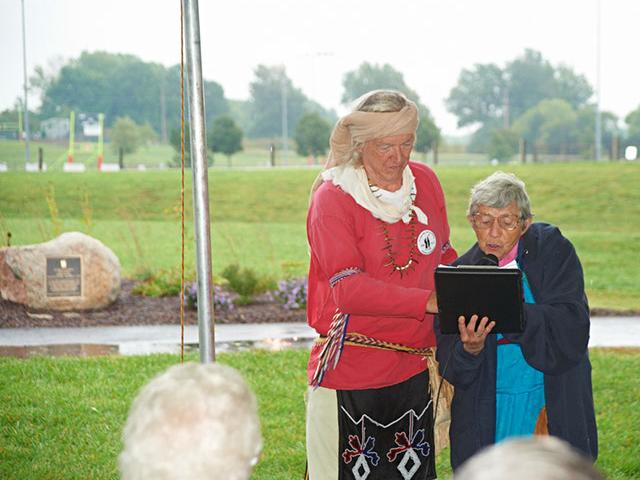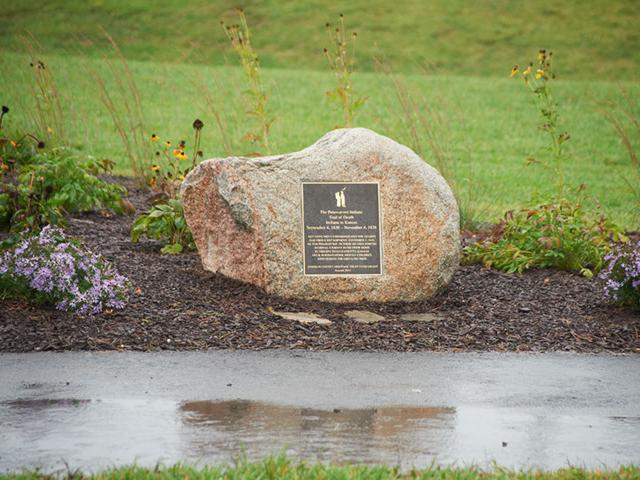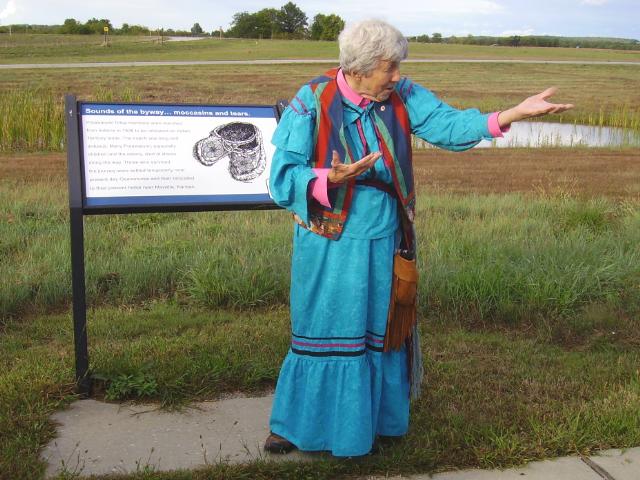|
By Shirley Willard, Fulton County Historian Sept. 28 Saturday - We woke up in Independence, Missouri, and crossed into Kansas. It was raining as we stopped at Grandview’s Red Bridge and Minor Park but only a few hardy souls braved the wind and rain to take umbrella in hand and walk to the Trail of Death historical marker. The park has historical signs for the Santa Fe, Chisholm, Oregon and California trails that all ended or began there. We dedicated a new Trail of Death historical marker at Heritage Park, Olathe, Kansas. This is the same marker researched by Deb Sims, Spring Hill Middle School librarian, which replaces the marker at Stillwell. As we drove we read the 1838 diary for that location, which told of rain and getting lost for four hours as they wandered the prairie trying to find a trace of a trail. It rained on us too and we had a hard time finding the park, similar to what happened to them in 1838. Bill Maasen, park superintendent, had erected a tent and we were grateful as it continued to rain during the dedication ceremony. There was a good sized crowd, maybe 50 people. The Citizen Potawatomi Nation had provided us with flags to put on our cars, but they kept breaking off. The flags were left over from the 2008 caravan and maybe the plastic was getting old. The flags were like those used for funerals. When our caravan of 10 to 12 vehicles came down the road, some people pulled off the side, thinking we were a funeral procession. We drove to Paola for lunch at Beethoven’s restaurant, hosted by the Miami County (Kansas) Historical Society. They sang Happy Birthday to me and gave me a card that they had all signed. Bill got me a big chocolate chip cookie, a specialty of Beethoven’s. It is about two inches thick and five inches diameter. They also gave me a big slice of German chocolate cake to go. It was a grand 77th birthday. We visited Paola’s Swan River Museum to see the artifacts from the Sugar Creek Mission where the Potawatomi lived 1838-1848. They gave each of us an old rusty nail from the cabins built in 1838 at St. Mary’s Mission at Sugar Creek, where the Potawatomi lived the next ten years, until they moved further west in 1848. The mission cabins had been burned and that left a line of old nails tracing the walls of the buildings. We next traveled to Osawatomie, the end of the 1838 Trail diary, stopping at the Old Land Office where the Trail of Death marker sits beside a John Brown - Civil War marker. We also visited the Osawatomie Museum, which is a big old train depot with several rooms of model trains and train memorabilia. Though we have been through Osawatomie many times in the past, this was the first we visited that museum. That evening we visited Trading Post, Kansas, museum. We met the family that started the museum in the 1970s. Alice Widner is the museum curator. She copied a page that told of a traveler who stopped by Sugar Creek mission and stayed in one of the abandoned buildings. So apparently they were not all burned when the Potawatomi left in 1848. We dedicated another new Trail of Death marker. This was a highway rest area and the sign was erected two years ago but we did not know about it until this year. Then we ate supper at Long Horn Restaurant. There were 23 of us. Some of our caravan were not there but some new people joined us for supper.  George Godfrey and Sister Ginger Pearl speak at the dedication of the new Trail of Death historical marker at Heritage Park, Olathe, Kansas. It was raining and the park department had erected a tent. The historical marker is seen at the left. (Photo: Sharon Hoogstraten)
George Godfrey and Sister Ginger Pearl speak at the dedication of the new Trail of Death historical marker at Heritage Park, Olathe, Kansas. It was raining and the park department had erected a tent. The historical marker is seen at the left. (Photo: Sharon Hoogstraten)
 Close up of the new historical marker at Heritage Park, Olathe. This is the first Trail of Death historical marker to use the Potawatomi Trail of Death Association logo designed by David Anderson. It appears on the historic highway signs but the historical markers were erected before the logo was made. Most of the historical markers are boulders with metal plaques. (Photo: Sharon Hoogstraten)
Close up of the new historical marker at Heritage Park, Olathe. This is the first Trail of Death historical marker to use the Potawatomi Trail of Death Association logo designed by David Anderson. It appears on the historic highway signs but the historical markers were erected before the logo was made. Most of the historical markers are boulders with metal plaques. (Photo: Sharon Hoogstraten)
 Trading Post, Kansas, rest area at intersection of U.S. highway 69 and Kansas 52 has nine historical signs. This one tells about the Trail of Death. Sister Ginger Pearl tells about her family history and how her great-grandmother Theresa was a little girl on the Trail of Death. (Photo: Shirley Willard)
Trading Post, Kansas, rest area at intersection of U.S. highway 69 and Kansas 52 has nine historical signs. This one tells about the Trail of Death. Sister Ginger Pearl tells about her family history and how her great-grandmother Theresa was a little girl on the Trail of Death. (Photo: Shirley Willard)
|
| < Previous | Home | Next > |